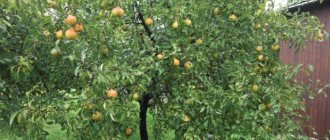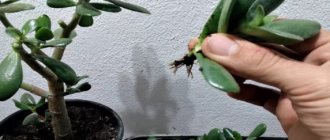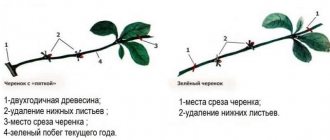Which propagation method is the most effective?
There are quite a few methods for propagating grapes and germinating them at home, but cuttings are considered the most common in terms of the number of planting stems that take root. This method is easy and allows you to get a good percentage of surviving cuttings. The seedlings take root well. There are no problems during transplantation. At the same time, every grape specialist understands exactly that all the genes of the mother variety are preserved in this seedling.
As a result, this technique is also the most effective. Based on the opinions of winegrowers, propagation in peat tablets is recognized as an effective method of germination. When young roots grow, the scion is painlessly, without causing damage to the root system, planted in the soil directly with the tablet.
At the same time, you can skip the cup process, which also reduces time.
The germination method using peat tablets is the fastest, because... the tablet itself is simultaneously impregnated with compounds to accelerate growth.
Tips and tricks
Growing grapes is not a difficult process in itself. Both a beginner, a professional or an avid gardener can try out layering propagation methods. They are suitable for any climate zone: from hot to Siberia. The new plant will be strong and healthy if it first receives proper care and attention.
- Choose the sunny side and fertile soil for planting, and even more so for propagating the crop, because when new specimens appear, the consumption of nutrients increases and the soil gradually becomes scarcer. This is why it is important to initially choose rich and fertile soil.
- In order to measure the length of the shoots, use a measuring tape (popularly called “centimeter”), and rope, wire or twine are suitable for gartering.
- Remember that you need to remain calm when replanting so as not to damage the shoots or the unformed root system and do everything as it should be.
Different varieties of grapes are more down to earth with different types of propagation and it is worth choosing the method of propagating the grapevine carefully and wisely. When choosing, attention should be paid to climatic conditions (layering is suitable for any), grape variety, time of year, your own skills and abilities, as well as the goals that are set at the head of the transplant.
How to prepare and store cuttings
To achieve results and quality seedlings, be sure to follow the rules and properly prepare cuttings and store them until germination time. When is the right time to cut the material? Grape cuttings are cut and selected in the fall. For this purpose, lignified strong vines are selected, but before the onset of frost.
During this period, the sap flow has subsided, so this material is stored well until spring. Storing cuttings involves the process of proper preservation. Divide the cuttings into piles, by variety, tie them up and label them. As a rule, cuttings are stored in a cold place.
Either this is the basement - stored in a box in damp sand, or in the refrigerator - wrapped in material and placed in a plastic bag. Growing grapes from cuttings begins in early spring. To do this, begin preparing for the process of rooting cuttings. By cutting the ends of the vine on both sides, the vine is awakened from hibernation. After this you need to soak the vine.
The water must be clean, so don’t forget to change it. Cuttings that have germinated are called chubuks. Woody vines are harvested for this process in the fall, but green vines can also be used in the spring. Cuttings require a lot of work, but the result is the most effective.
Which method is the most optimal?
Planting of grapes is carried out mainly with own roots and grafted seedlings. And very rarely they are grown from seed. From seed is a very long process, and if the winegrower is not a breeder, then it is better to focus on the other two types: cuttings or grafted seedlings. Each of them has its own advantages and disadvantages.
Cuttings
Advantages:
- They are compact, transportable;
- Well stored;
- The cost of a cutting is cheaper than a grafted seedling;
- The risk of introducing diseases and pests is reduced. The same phylloxera that lives on the root system;
- You can grow any grape variety from a 60–70 cm piece of vine.
The disadvantage of cuttings as planting material is that they are less frost-resistant than grafted seedlings. Therefore, such an operation as catarrhosis and covering the bushes for the winter will be necessary in the conditions of the central regions of the country.
Planting cuttings in autumn is not practiced.
Grafted seedlings
The advantages of this type of planting material:
- The survival rate fluctuates around 100%. Of course, subject to proper planting and care;
- In the second year after planting they begin to bear fruit;
- More frost-resistant than self-rooted ones. Less susceptible to diseases. Have higher yields;
- Can be planted both in autumn and spring when the soil warms up to 6–8 degrees.
Flaws:
- It is more difficult than cuttings to transport and store. Storage rooms should have a comfortable temperature and relative humidity;
- Increased risk of introducing diseases or pests into your vineyard. Therefore, even when purchasing planting material from a nursery, it is necessary to treat the roots of the seedlings with a phylloxera solution before planting.
Why is the germination stage necessary?
For cuttings, only strong and powerful vines are used. Often roots appear and grow in 3-4 weeks. When the rooting process takes place in water, you can observe this process. It is also possible to plant chibuks directly into open soil. Use a substrate for germination. Planting in open ground allows you to bypass transplanting grape seedlings.
Preparing the cuttings for rooting
Cuttings that have overwintered in a cold place need to be properly prepared for rooting. Preparing grape cuttings for germination step by step:
- At the beginning of March we take planting material from the shelter. We check visually for the absence of rotting and dark spots. Trim the ends to 1 cm.
- We soak them in natural water for several days. You need to change the water a couple of times. Why natural? Because the tap water contains chlorine, which can negatively affect the material.
- We treat with a growth stimulator. There are a lot of them now in any garden store. Common ones are Kornevin, Epin, etc. To soften, you can add a little honey water.
Rooting methods
Various methods of rooting grape cuttings are used. Germination in water is recognized as the simplest. Or it is also common to germinate chibuki in a substrate. The technique is similar. Small containers are used.
On foam plastic
Involves the use of foam floats to reduce maintenance.
- Cut foam cubes 3 by 3 cm.
- Make a hole in the middle. We thread the cutting. When you place it, it should be firmly secured in the foam.
- We use a large container of water. We immerse the prepared material there for 20 days.
- Watch the water. Change it up sometimes.
Germination in a jar of water
The most commonly used method to germinate chibuki.
- We use a liter jar. Pour water to 4 cm height. The water should be about 23 degrees.
- We lower a bunch of cuttings into it. Watch the water. Because turbidity may be released.
- The jar needs to be placed in a bright place; a window sill is perfect. The water will slowly evaporate, so add to the same level, it is important not to overfill.
- In about a month, roots will appear. When they grow to 3 mm, they can already be planted in the ground.
Germination in peat tablets
They are usually purchased at gardening stores.
- We dip the tablets in water to swell and fix the pipes in them.
- Be sure to cover the top with film so that the soil does not dry out.
- Check and add water as it dries.
- Germination of grape cuttings takes about a couple of weeks. Roots appear.
Germination in sawdust
Sawdust from their pine needles is the best substrate for the germination process.
First, pour sawdust in a 4 cm layer
Secondly, we place the pre-soaked planting material in the center of the container.
Thirdly, we moisten the sawdust and sprinkle it with a slightly dry layer so that the main one does not dry out.
Fourthly, we monitor the humidity of the substrate.
Fifthly, we are waiting for the germination of callus on grape cuttings and further roots.
It is possible to mix the substrate with coarse sand or humus. Depending on the variety, grapes take up to 4 weeks to take root.
Puzenko's germination method
This method was invented by Natalia Puzenko. Gives excellent results. Firstly, soak the material in water and wring it out. Secondly, spread the fabric on the surface and wrap the cuttings on all sides. Thirdly, we place this bag in a bag and wait 21 days until the roots appear.
Let's take a look
Picking grapes
This is a very well known method for experienced gardeners. The essence of kilching is the process of imbalance, for the awakening of buds, as well as the appearance of roots. This method increases the percentage of rooted chibouks. The cuttings are placed in a plastic container with moistened sawdust and placed on a heating radiator. Those. conditions are created for the lower level - the pipes should be kept warm, and the upper level - in a cool place. This is a difficult method to carry out at home. Due to thermal imbalance, the root system is stimulated. This method is used only for germinating cuttings in the spring. It is not suitable for germinating grapes in the fall.
Because In the fall, chibuki are usually soaked for several days and planted in the ground. Before this, to prevent diseases, you can treat it with weak potassium permanganate.
Rooting in spring in a plastic container
After completing the stage of germination of grape roots, before planting in the soil, you need to strengthen the cuttings. To do this, chubuks with 3 mm roots need to be placed in a high container with light soil. Use either cut-off bottles or large glasses (disposable). Different varieties have different periods of germination and rooting. Some last up to 6-7 weeks. When to plant cuttings in spring or winter? The beginning of preparations for the process of planting cuttings at home is the end of February.
When stable warm weather sets in in the spring, the germinated seedlings are planted in the ground.
Transplanting into plastic bottles
We adhere to the following steps:
- Cut off the top of the bottle
- Make holes in the bottom of the container to drain water
- lay drainage (expanded clay can be used), then lay out a layer of soil mixed with coconut shavings.
- Carefully insert the pipes into the prepared loose soil.
- Cover the top with polyethylene. Or you can make a cap from the top of a cut bottle.
- monitor soil moisture.
The cutting will take root in a few weeks. Properly care for the planted chibouk. Water in a timely manner, loosen the soil, add fertilizer. You can mulch a little, the moisture will drain away more slowly.
Transplanting into cups
You can also use large plastic glasses to transplant germinated grape seedlings. If you plant unrooted chibouks directly into the ground, the process will take longer. We put sawdust soil in cups and add any type of organic matter or turf. You can add chopped leaves. Planting in containers is done in the same way as glasses and bottles.
Water up to 3 times a week. This is necessary to prevent moisture from leaving too quickly. You can also cover the top with plastic. However, ventilate it periodically. Place the seedlings in a bright place. When the roots have grown and 4 leaves appear, reduce watering. This will activate the growth process of new shoots. The next stage is planting the seedling in a schoolhouse or in a large container.
We recommend reading an interesting article about Maiden grapes.
Lignified method - breeding with lignified layering
This type of reproduction is also carried out in the spring, or in extreme cases in the fall. The hole being formed should be about sixty centimeters deep and located towards the lowest shoot from the bush. A mixture of manure and black soil is poured into the hole, everything is carefully dug up and only then the layering is buried. Moreover, a shoot with three eyes should remain on the surface.
If the bush urgently needs to be propagated in the fall, then the upper part of the cuttings, left on the surface, is covered with a twenty-centimeter layer of earth. Usually in the first year new branches grow on the cuttings and you can even harvest a partial harvest. Separation from the main bush is made only after three years.
Fertilizers for cuttings
You need to know that cuttings, like grapes, lack nutrition. This is very important during the period of root formation. Then you will root the grape cuttings correctly, because... they will have enough food. However, fertilizers are applied in a dissolved composition.
Correctly use mineral complexes, which include nitrogen (2g), potassium (2g) and phosphate (2.5g). Dissolve the complex in 5 liters of water. We fertilize grape cuttings every 14 days.
To make the process of callus appearing on cuttings faster, use mineral complexes. Suitable for this purpose are complexes that consist of nitrogen - 2g, phosphate - 2.5g, potassium - 2g.
Dilute this in 5 liters of water. After 14 days, it is advisable to repeat feeding.
Propagation by green cuttings in summer
Another method of propagating grapes is propagation in summer by green stems. In the summer, shanks are cut from vines and new branches that are unnecessary after trimming the excess growth. As a rule, this is done in May.
Dip the cut vines into water or wrap them in damp material and place them in a cool place for 24 hours. For good survival, leave the middle part of the branch. For germination, you can choose any of the above methods. First, Next we make cuts on the vine, leaving 2 leaves and 2 buds. We cut at least 1.5 cm of the column above the top bud. We break off the bottom sheet and cut off half of the top one. Secondly, we dip the prepared chibouks into the heteroauxin solution by 1/3. Soak for up to 10 hours at temperatures up to 22 degrees, not in direct sunlight, but in the shade. Thirdly, we place the workpieces in the soil in a deep container or box. The soil should consist of 10 cm of fertile soil and 6 cm of sand. Fourthly, we plant the chibuki in moist soil, placing planting material up to 3 cm deep and at a distance of 10 cm between them. Then we cover the box with glass. Fifthly, we constantly monitor the soil moisture. Be sure to spray the cuttings up to 5 times a day, or water them daily.
Sixth, after a month you can begin hardening the cuttings. To do this, open the drawer for up to 15 minutes in the evening. If the roots develop well, the growth can be up to 50 cm by autumn.
Replanting and caring for young bushes
In the spring, while the buds have not yet opened, they plant cuttings in open ground. The whole process looks something like this:
- The day before planting, prepare a hole, at the bottom of which crushed stone and soil with fertilizers are placed. Allow to settle so that soil sediment does not damage the young stem.
- From the container in which it overwintered, it is moved into a hole and sprinkled with the top layer of soil. Water, then fill the hole.
- To better retain heat, some cover the ground with black polyethylene.
- After that, approximately 30% of the leaves are removed.
- As they grow, they tie them up.
Important! During the summer, the young bush needs to be watered abundantly once every ten days.
In this way, by layering you can easily propagate those grape varieties that cannot be propagated by cuttings, without the risk of losing the variety. If you follow all the digging conditions and after transplanting the cuttings into the ground, properly care for them, a good result will not be long in coming.
Planting cuttings directly in open ground
This method is used in the fall. At the same time it is one of the simplest ways. The process is as follows:
- — we sort the chibouks, choose healthy ones without obvious damage. We make oblique cuts at the ends;
- — we lower the chibouk into a pre-prepared trench or hole at a depth of 60 cm, placing it at an angle of 45 degrees.
- — leave no more than 1 bud on the surface;
- - then we dig in and water well.
- — we carry out regular watering before the arrival of frost;
- — for the winter we cover it with straw or a bag;
- - We open it when spring comes and wait for the first green leaves.
How to plant layering correctly
To learn how to plant layering correctly, you need to follow certain recommendations:
- near the mother bush you need to dig a trench, about 50 - 60 cm wide and deep;
- the walls of the hole should be vertical, and the bottom should be at an angle of 35 - 45 degrees to the bush trunk;
- humus or manure, mineral fertilizers and soil are placed at the bottom of the groove;
- remove all leaves and eyes from the shoot selected for burying in the ground;
- 3-4 leaves are left on the outer tip of the shoot;
- after placing the shoot in the ground, the trench is half covered with earth and watered;
- as moisture is completely absorbed, the hole is completely filled up and the soil is compacted;
- It is necessary to periodically water the soil around the bushes.
Propagation of grapes by digging in vines
Sometimes not every grape variety can be propagated by cuttings. There are very capricious varieties that die when cuttings are taken. For this there is a method by layering, i.e. by digging grape vines. With this propagation method, you can get several new varietal grape bushes per season. Difficult to root varieties receive additional nutrition from the mother bush and they have enough strength to develop their root system.
We recommend an interesting article: Propagation of Beautiful Maiden Grapes.
What is grape layering?
One of the most common and simple methods, known since ancient times, is propagation by layering. The method has proven itself in the cultivation of difficult-to-root grape varieties. The method shows good survival rates in areas not susceptible to root system diseases.
Layerings are rooted, buried stems, separated from the mother bushes and used as seedlings for subsequent propagation. Direct connection with the parent plant provides ideal conditions for nutrition, development and root formation in young stems.
A large number of adventitious roots are formed on them, which contributes to the rapid establishment of the crop. They are obtained by digging up the ground part of the vineyards or shoots.
Performing Chinese layering
Chinese layering differs from conventional digging in that the lignified vine is completely buried in the soil. This method is used for the most difficult varieties to root. In early spring, the longest vine is selected, which grows from the trunks of the bush. Next to the bush, they dig a trench 20 cm deep and lay the vine in it, pin it to the ground and dig it on top. The soil is well fertilized.
Initially, sprinkle the ditch with no more than 5 cm of soil. As soon as buds appear and shoots begin to appear, they continue to gradually sprinkle soil. The trap must be kept moist at all times. As a rule, each bud produces a new shoot. In the fall, you need to carefully dig up and divide new bushes. But in order to grow strong seedlings, you have to sacrifice the number of grape bunches, break off all the shoots and young shoots in the summer, and reduce the load on the bush.
There are 5 methods of layering, which you can study in more detail in the following material. Firstly, the Underground method Secondly, Perennial layering Thirdly, Hilling the head of the bush Fourthly, the Air method Fifthly, Kataviak, daldarama and lugenda
Cataviac and Chinese methods
These methods are most often used to repair vineyards; they are used mainly in the spring. The first involves layering a whole bush.
When using the second one, a horizontal vine, already well-ripened, located in the lower part of the grape bush, is used as a branch. It is placed in a hole, the depth of which must be at least 20 centimeters.
Chernozem and humus are first added. The vine is secured with a pin or wire. Those eyes that are not covered with earth are removed with a knife.
Grape propagation by grafting
Grapes can be propagated by grafting, like many fruit trees. For grapes, common grafting methods include splitting, budding, and others. Grafting can be done with cuttings from the previous year, or cuttings from the current year. Hence the names “black to black”, “black to green”. In the spring, before the sap begins to flow, the “black to black” method is often performed. To do this, they use chibouks that were cut in the fall and overwintered in a cool place.
You can study vaccination methods in more detail in the following material. We learned how to properly grow grapes from cuttings, as well as the most commonly used methods of grape propagation.
The key to success depends only on your careful care of all grape germination processes. Choose the most suitable option for you for germinating grapes from cuttings at home and good luck to you!
Advantages and disadvantages
Like any other propagation method, the layering method has its pros and cons. It is important to determine in a particular case the risks of harming the vineyard.
Advantages of propagating grapes using the layering method:
- low material and time costs;
- greater chance of a new plant taking root;
- the daughter bush gets more opportunities for growth and development;
- the opportunity to soon (literally within a season) harvest from the resulting new bush;
- you can get a large number of grape bushes with the desired qualities;
- the presence of great variability in the choice of methods.
The disadvantages of this method of propagating grapes include weakening of the mother bush and a high risk of phylloxera infection. When young grapes are propagated by green layering, it is important at first to carefully monitor the standing of the operated plant, both the mother bush and the layering itself.











